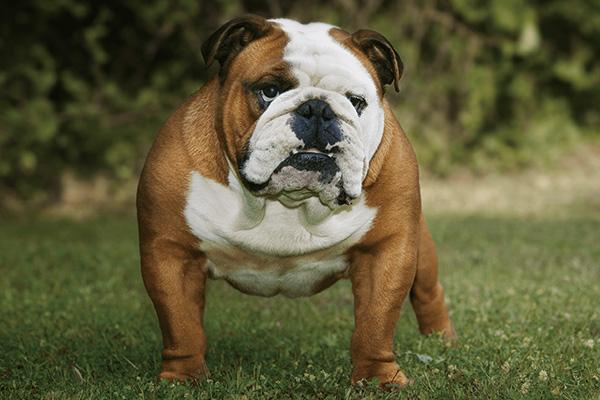Bulldog
IUCN
LCBasic Information
Feature
The breed is characterized by well-developed muscles, a stable body, wrinkled face, and a distinctive flat nose.
Distribution and Habitat
Originated from the UK
Appearance
The head is large, square, with the circumference of the head (before the ears) at least equal to the height at the withers, the distance from the lowest corner of the jaw to the top of the skull when viewed from the front is quite long, and the distance from the nose to the occipital bone when viewed from the side is quite short, the forehead is flat; the cheeks are round and protrude to the sides, exceeding the range of the eyes; the stop is clear, forming a groove between the eyes. The eyes are set relatively low on the skull, the line between the corners of the eyes is at right angles to the stop, the eyes are round and of medium size; the ears are high, small and thin, and are typical "rose ears"; the nose is large, wide, black, and the tip of the nose is set back and located between the eyes; the upper lip is thick, wide, and pendulous, located on both sides of the lower collar, and merges with the lower lip in front to just cover the teeth; the teeth are undershot. The
Details
The English Bulldog originated in the United Kingdom. Some people also call it the Tiger Dog. It originated in the British Isles. Its ancestors are said to be the combination of the Mastiff and the Bulldog. Although the English Bulldog looks scary, it is actually a kind, friendly, loyal breed. It also has courage and great endurance, so it is known as the national dog of the United Kingdom.

Before the 17th century, the breed associated with bullfighting was called the Bulldog. After several generations of selective breeding, the English Bulldog became one of the most powerful species and its original wildness was minimized. This is the Bulldog we know today, a breed that we can be proud of for a reason. By 1835, bullfighting as a sport was considered illegal in the UK. Therefore, for various reasons, the British bulldog became less and less valuable and even had the possibility of extinction. Some dog lovers were very disappointed to see the end of the breed, so they took on the responsibility of saving the breed without hesitation. It is said that the bulldog at that time was more aggressive than the bulldog today. Based on this, it can be roughly judged that the breed of its ancestors may be the mastiff that was introduced to Britain in the 6th century BC.
The British bulldog has a strange and cute appearance, walks in a gentlemanly manner, has a calm personality, does not bark randomly, is very friendly, kind, trustworthy to people, kind to children, and at the same time, generous, brave and majestic. Since the British bulldog ended its identity as a fighter, it now has multiple functions as a guard dog, military dog, and police dog. Today, it is mostly loved by people of all walks of life as a precious companion dog, especially a companion dog that embodies the style of men. Suitable for family breeding in a relatively spacious environment.
Protect wild animals and stop eating game.
Maintaining ecological balance is everyone's responsibility!








